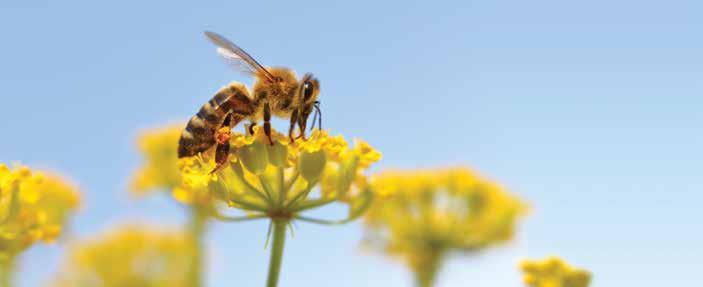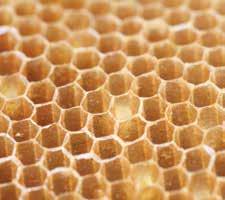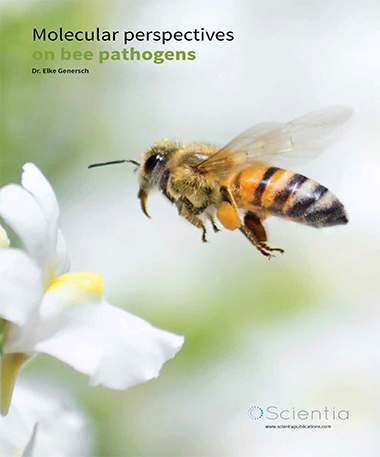Dr. Elke Genersch – Molecular Perspectives On Bee Pathogens
With a solid career in human molecular medicine in her back pocket, Dr. Elke Genersch decided to put her skills to the test in another organism – the honeybee.

Almost 15 years ago you decided to change the focus of your research from human to bee diseases. What circumstances led you to choose bee disorders over the human counterpart?
At the time, I was working with molecular medicine and cancer research in Lund, Sweden. Because I wanted to come back to Germany, I started to look for an attractive position in academic research in and around Berlin. In this situation, I was offered the position as Head of Department for Bee Diseases and Vice Director of the Institute for Bee Research. After short meditation I accepted the challenge to switch from humans to bees and from tumors to pathogens because principally the way of scientific thinking stays the same. My solid background in molecular biology and my previous experience in virology helped me a lot and I habilitated 5 years later with a thesis on American Foulbrood and became an Associate Professor for Molecular Microbiology with the Faculty for Veterinary Medicine at the Freie Universität Berlin.
What do you find most rewarding about studying bee pathogens?
When I started working in this field, very little was known about bee pathogens on a molecular level. This was – and still is – the most rewarding part for me. There were so many open questions regarding pathogens and pathogen-host-interactions that every idea could potentially lead to a new project – and many did. Since the questions were new, most of the results were also novel and changed the view we previously had on the pathogens. An example is the reclassification of the etiological agent of American Foulbrood, Paenibacillus larvae, and our finding of the existence of distinct genotypes, which have evolved different virulence strategies. These results were highly relevant from a practical point of view and were almost immediately incorporated into the laboratory-, and clinical diagnostics procedure of American Foulbrood. Our results really made a difference! However, working with these pathogens is much more difficult than working with established model organisms. There are no molecular tools easily available and you cannot just order your reagents, kits, or antibodies from a catalogue. Therefore, to work with bee pathogens on a molecular level always feels like being a pioneer; there are no quick and easy solutions to experimental problems.
You have been involved in the recent startup of the Smart Bees project. Describe your role in the consortium.
My group will be involved in studying the triangular interactions between honeybees, deformed wing virus and the ectoparasitic mite Varroa destructor; V. destructor acts as a mechanical – and sometimes also biological – vector of deformed wing virus. We and others have previously shown that V. destructor, acting as a biological vector of deformed wing virus, can be an evolutionary bottleneck for the virus, selecting for more virulent variants. We will further analyze this finding, together with the immune response of the honeybee to Deformed wing virus infections.
What practical implications do you hope your research will have in the future?
In order to combat a disease, you first need to understand the pathogen, its mode of action, its virulence mechanisms, its spread, and the factors influencing the success of the pathogen. By working on these topics and by furthering our understanding of all these pathogen-related topics I hope to contribute (i) to cures against bee diseases and (ii) to preventing the spread of bee diseases – not only between honeybees but also to other pollinators. I believe that our results will contribute to determining pathogen threats, and to enhance honeybee resistance mechanisms to parasitic disease.
Advancing virulence research
Leading an ambitious program of bee research, Dr. Genersch’s molecular outlook is likely to alter the way we view the diseases of bees and other insect pollinators. Her novel approach to understanding an old problem is fast-forwarding the understanding of key factors mediating a rapidly spreading decline in the world’s pollinator populations.
A PIONEER IN AN OLD FIELD
Beekeeping is an ancient pursuit, but as with many other chores we have brought into our modern times, beekeeping is now surrounded by a range of problems. Most of the issues are health related. While the demand for honey has led to a worldwide increase in honey bee management, bee diseases have been also on the rise for several decades. These diseases cause extensive problems with winter losses of bee populations.
Dr. Genersch’s knowledge in molecular medicine turned out to be an invaluable asset for bee research, but not out of the bee perspective. Instead, Dr. Genersch has answered many important questions regarding bee diseases focusing on the molecular secrets of the pathogens. The molecular interactions between bees and their pathogens are also under her looking glass, and she is hence taking a novel approach in a field dominated by researchers focusing on the bees.
THE SECRETS OF A GENE SEQUENCE
American Foulbrood is the name of the most devastating of diseases affecting bee larvae (going under the technical name ‘brood’). Initially described in terms of the foul smell accompanying the infection, the disease is lethal for the infected larvae and eventually kills the whole colony. The radical treatment of disease outbreaks includes the destruction of infected hives – a costly measure for beekeepers.
American Foulbrood is caused by the bacterium Paenibacillus larvae. The disease has been studied for decades; yet, the classification of the causative agent has been under constant revision since its identification in 1906. Prior to Dr. Genersch’s engagement in the field, researchers believed the causative agent was divided into two subspecies.
Using repetitive element sequence basedpolymerase chain reaction, a molecular technique optimal for studies of microbial subspecies, Dr. Genersch’s group managed to Advancing virulence research Leading an ambitious program of bee research, Dr. Genersch’s molecular outlook is likely to alter the way we view the diseases of bees and other insect pollinators. Her novel approach to understanding an old problem is fast-forwarding the understanding of key factors mediating a rapidly spreading decline in the world’s pollinator populations. reveal that what was previously considered as two species subspecies, was actually one species encompassing four different genotypes – named ERIC I-IV.
The key idea that allowed Dr. Genersch’s group to succeed where others had failed was the comparison of the genotyping data to phenotypic observations of the bacteria. Differences in virulence – the strategy the pathogen uses to infect its host – accounted for a majority of these phenotypic differences. Dr. Genersch hence set out on a path to molecularly characterise the virulence factors of the different ERIC genotypes.
Using suppression subtractive hybridization and comparative proteome analysis in combination with gene inactivation experiments, they identified two toxins specific for ERIC I, and a protein specific for ERIC II, involved in the pathogenesis of the respective genotypes.
They also found a chitin-degrading enzyme, common to all P. larvae, which is crucial for the infecting process. The gut of bee larvae is lined with a chitin-rich layer, being one of its main barriers towards intestinal pathogen infection. By first destroying this layer, the bacteria create a route to entering and kill the larvae.
Further analysing the gene sequence of P. larvae, Dr. Genersch also predicted that the bacterium likely produces substances with antimicrobial or cytotoxic properties. Many antibiotics, or cytostatic drugs used in cancer medicine, are products originally isolated from bacterial strains producing similar substances.
The prediction turned out to be correct and in a close collaboration with Professor Roderich Süssmuth, she managed to isolate and characterise two novel substances having antimicrobial activity; paenilamicin and sevadicin.
This discovery undeniably opened up new avenues in Dr. Genersch’s research: “On the one hand, we are now interested in understanding the mode of action and the biological role of these secondary metabolites. On the other hand, we are of course interested in determining their potential for human and veterinary medicine”, she says.

CLIMATIC IMPACTS
The effects of a changing climate can be spotted in all areas of life – beekeeping being no exception.
The microsporidian fungus Nosema – an obligate intracellular pathogen – was until recently not viewed as a great threat to honeybees. The Nosema fungus harbours two subspecies; one infecting the European honeybee (N. apis), and one used to be known for infecting only the Asian honeybee (N. ceranae). A couple of decades ago, however, European beekeepers started reporting losses of their colonies due to infection with N. ceranae.
It is now known that N. ceranae can indeed infect both bee species, and the infection is often more severe when European bees are infected with the Asian form of the fungus. Unlike its local cousin, N. ceranae namely has the ability to suppress the immune system of the European bees.
Looking further into the issue with colony deaths caused by N. ceranae, Dr. Genersch noticed a clear regional pattern of infection. Death of colonies had been reported mainly in Spain or other southern European countries, while a thorough investigation of Nosema strains in Germany revealed that N. ceranae could not be held accountable for colony deaths in this temperate region.
Suspecting a climatic influence on the virulence of N. ceranae, Dr. Genersch investigated the spore germination of the two subspecies, finding that N. ceranae lost its spore germination ability at temperatures below +4°C – a temperature not affecting N. apis.
“Warmer winters and hot summers are obviously beneficial for N. ceranae”, says Dr. Genersch. “Thus, any climate change in this direction will be advantageous for N. ceranae; this pathogen will become more prevalent and will possibly replace the rather benign species N. apis. If the climate continues to change, colony losses due to N. ceranae infection may pose a new threat to the beekeeping and pollination industry”, she states.
THE BENEFITS OF CELLS IN A DISH
Studying intracellular pathogens, such as the Nosema subspecies, requires living cells. Bee cells are notoriously difficult to culture, leaving researchers to examining infected bees – a tedious practice considering that the bee season is rather short in the northern parts of the world.
Again, using her ability of thinking outside the box led her to find a solution where others found none. Since all previous attempts to produce a permanent bee cell line had failed, Dr. Genersch turned her gaze to cells originating in the order Lepidoptera; including butterflies and moths. The Lepidoptera cells turned out to be susceptible to infection with the Nosema subspecies, and Dr. Genersch’s determination led to the development of the world’s first cell culture model for studying Nosema subspecies. And since obligate intracellular bee pathogens were believed to be impossible to culture, this is, in fact, the first honeybee pathogen ever grown and studied in cell culture.
The model, extremely valuable for molecular investigations of virulence factors, can also be used as a screening assay that allows testing substances for activity against Nosema subspecies: “With our publication, we wanted to draw the attention to the fact that we now have a cell culture-based medium throughout screening system, available for quick identification of substances with activity against Nosema”, says Dr. Genersch, inviting any parties interested in testing substances against Nosema to establish collaboration with her group.
SYNERGISTIC INTERACTIONS
First found in Southeast Asia at the beginning of the previous century, the parasitic mite Varroa destructor has spread from its native region with the help of modern beekeeping practices and is now present worldwide.
Varroosis is the most widespread infection of honeybees and it is blamed for a majority of bee colony winter losses. Recent research from Dr. Genersch’s lab has, however, made it clear that it is not the feeding activity of the mite in itself that results in the death of bee colonies.
Deformed Wing Virus is a close companion of the Varroa mite, infecting almost all colonies where a mite infection is present. Researchers still argue whether the virus existed in the European bee population prior to the arrival of the mite from Asia in the 70’s, or if the virus and the mite spread together. Be that as it may – they now coexist in bee colonies around the world.
The virus has been associated with the appearance of bees with deformed wings – a sign that colony collapse was imminent. It was not until the thorough investigations by Dr. Genersch that it became clear that the death of bee colonies ascribed to the Varroa mite was actually a result of a synergistic coexistence of the mite with the virus.
Deformed Wing Virus doesn’t cause any symptoms in infected bees, unless the virus replicates in the mite prior to transmission to its bee host, turning the mite into a biological vector. Mechanical transmission, with mites acting as transient hosts spreading unreplicated virus, doesn’t pose any apparent threat to bees.
“When we started to work on Deformed Wing Virus, its replication in mites and the relationship between the replication and the occurrence of overt infections was unknown. We were the first to prove Koch’s postulates for crippled wings”, says a proud Dr. Genersch.
Indeed, Dr. Genersch has all the right to be proud. Pioneering the field of molecular bee pathogen research, in a short time, she has contributed to findings that have changed the view of several of the diseases, providing knowledge that might ultimately also help saving other pollinators.
Meet the researcher
Dr. Elke Genersch
Deputy Director, Institute for Bee Research
Hohen Neuendorf and Professor, Department of Veterinary Medicine
Freie Universität Berlin, Germany
Following an educational background in molecular biology, virology, biochemistry, and molecular microbiology, Dr. Elke Genersch research career took the route over human molecular medicine before she joined the field of bee pathology in 2001. She is now a key player in the German Bee Monitoring project, she participated in the European Bee Monitoring efforts, and has been leading the working group “Pests and Pathogens” within the COLOSS network – an association for honeybee research. Dr. Elke Genersch is a member of the Editorial Board of Applied and Environmental Microbiology and an Associate Editor of the Journal of Invertebrate Pathology.
CONTACT
T: +49 3303 293833
W: http://www.smartbees-fp7.eu
W: https://www2.hu-berlin.de/bienenkunde
KEY COLLABORATORS
Prof. Lothar H. Wieler, Robert-Koch-Institut Berlin, Germany
Prof. Roderich Süssmuth, Technische Universität Berlin, Germany
Prof. Christina Schäffer, Universität für Bodenkultur Wien, Austria
Prof. Rolf Daniel, Georg-August-Universität Göttingen, Germany
FUNDING
German Research Foundation (DFG)
Federal Ministry of Food and Agriculture through the Federal Office for Agriculture and Food Ministries for Agriculture of the Federal States of Brandenburg, Saxonia-Anhalt, Saxonia, Thuringia, and Berlin European Union (FP7)


